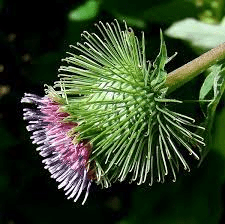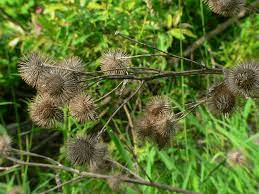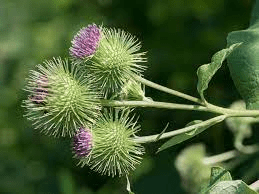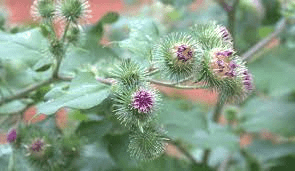Arctium lappa, commonly known as Burdock, is a biennial plant that belongs to the Asteraceae family. Native to Europe and Asia, Burdock has become naturalized in various regions around the world. It is known for its large leaves, distinctive burrs, and has historical significance in traditional medicine and culinary practices.
Morphologically, Burdock is a robust plant that can grow up to two meters in height. In the first year, it produces large, heart-shaped leaves that form a rosette close to the ground. In the second year, it sends up a tall flowering stalk with smaller leaves, and it produces prickly burrs that contain seeds.
The root of the Burdock plant is the most commonly used part for medicinal and culinary purposes. It is long, fibrous, and has a mild, earthy flavor. Burdock root contains various bioactive compounds, including inulin, essential oils, polyacetylenes, and antioxidants.
In traditional medicine, Burdock root has been used for its potential diuretic, anti-inflammatory, and antioxidant properties. It has been employed to support detoxification processes, promote skin health, and address conditions such as arthritis and digestive issues.
However, scientific research on the efficacy of Burdock for these purposes is still limited, and it’s crucial to consult with healthcare professionals before using it as a remedy.
Culinarily, Burdock root is used in some Asian cuisines, particularly in Japan, where it is known as “gobo.” It can be consumed raw, pickled, or cooked in various dishes, adding a crunchy texture and a mildly sweet, earthy taste.
Burdock has also gained attention for its potential as a source of prebiotics. The inulin content in the root serves as food for beneficial gut bacteria, promoting a healthy microbiome.
Despite its historical uses and potential benefits, it’s important to exercise caution when using Burdock, especially in therapeutic doses, as it may interact with certain medications or cause allergic reactions in some individuals. As with any herbal remedy, it’s advisable to seek guidance from healthcare professionals.
Burdock’s adaptability, distinctive appearance, and historical uses contribute to its continued interest in both traditional and modern contexts.
The Botanical Description of Burdock
1. Overview: Burdock, scientifically known as Arctium lappa, is a biennial plant belonging to the Asteraceae family. It boasts robust, branching stems, large heart-shaped leaves, and distinctive burrs that contain seeds. The plant can reach up to several feet in height and is characterized by its taproot, which is long, slender, and brown on the outside with a whitish interior.
2. Leaves: Burdock leaves are sizable, often reaching over a foot in length. They are dark green, with a slightly downy texture on the underside. The leaves grow in a rosette pattern, creating a visually striking base for the plant.
3. Flowers: Burdock produces globular flower heads that are surrounded by a series of hooked bracts, forming the characteristic burrs for which the plant is well-known. The flowers themselves are pink to purple in color and bloom from mid to late summer.
4. Roots: The taproot of the burdock plant is perhaps its most significant feature. It extends deep into the soil, sometimes reaching several feet. The root has a tough, outer layer and a crisp, sweet interior. It is the part of the plant most commonly used for medicinal and culinary purposes.
5. Habitat: Burdock is a hardy plant that thrives in various environments. It is often found in disturbed areas, along roadsides, and in fields. The plant has adapted well to different climates and is native to Europe and Asia but has naturalized in North America.
6. Lifecycle: As a biennial plant, burdock completes its lifecycle over two years. During the first year, the plant focuses on vegetative growth, developing leaves and the taproot. In the second year, it produces flowers and seeds, after which it typically dies.
7. Burrs: The burrs of the burdock plant play a crucial role in its reproductive strategy. They easily attach to passing animals or clothing, aiding in the dispersion of seeds. The hooked bracts of the burrs have inspired the invention of Velcro due to their effective clinging mechanism.
8. Adaptability: Burdock’s adaptability is evident in its ability to grow in various soil types. It is often found in areas with well-drained soil but can tolerate less favorable conditions. The plant’s resilience allows it to thrive in diverse ecosystems.
9. Folklore and Symbolism: Burdock has cultural significance in folklore and herbal traditions. It is often associated with purification and detoxification in herbalism. Additionally, the plant’s tenacious burrs have been seen as a symbol of tenacity and perseverance in the face of adversity.
The Geographic Distribution of Burdock

1. Native Regions: Burdock is native to Europe and Asia, where it has a long history of traditional use in herbal medicine and culinary practices. It was introduced to North America by European settlers and has since naturalized in various regions.
2. Naturalization in North America: Burdock has successfully naturalized in North America and can be found across the continent. It thrives in temperate climates and is often encountered in disturbed areas, along roadsides, and in fields.
3. Global Distribution: Apart from its native and naturalized regions, burdock has a global distribution, with variations of the plant found in different parts of the world. Its adaptability to diverse environments has contributed to its widespread presence.
4. Habitat Preferences: Burdock is commonly found in habitats with well-drained soil, but it can tolerate a range of soil conditions. It has been observed in meadows, woodland edges, and areas with moderate sunlight. The plant’s ability to thrive in various environments contributes to its ubiquity.
5. Climate Zones: Burdock is adaptable to different climate zones, including temperate regions. It can withstand both cold and warm temperatures, making it resilient in climates ranging from the cool northern latitudes to the warmer southern regions.
6. Human-Induced Spread: Human activities, such as the movement of goods and transportation, have played a role in the global spread of burdock. The plant’s burrs easily attach to clothing and animal fur, facilitating its dispersion to new areas.
7. Invasive Potential: While burdock is valued for its medicinal and culinary uses, its ability to spread prolifically raises concerns in some regions where it may exhibit invasive tendencies. Efforts are made to manage its growth in certain ecosystems to prevent ecological disruption.
8. Ecological Interactions: Burdock interacts with various organisms in its environment. Animals, particularly those with fur, aid in seed dispersal by carrying the hooked burrs to new locations. This ecological relationship contributes to the plant’s survival strategy.
The Chemical Composition of Burdock
1. Inulin: Burdock root is rich in inulin, a type of prebiotic fiber. Inulin promotes the growth of beneficial gut bacteria, supporting digestive health and contributing to a balanced microbiome.
2. Polyphenols: Burdock contains polyphenolic compounds with antioxidant properties. These compounds help combat oxidative stress in the body, potentially reducing the risk of chronic diseases.
3. Essential Oils: The roots of burdock contain essential oils, including various aromatic compounds. These oils contribute to the plant’s distinctive aroma and may have therapeutic benefits.
4. Tannins: Tannins found in burdock possess astringent properties. They may contribute to the plant’s traditional use in herbal medicine for skin conditions and wound healing.
5. Lignans: Burdock is a source of lignans, which have been studied for their potential anti-cancer properties. These compounds may play a role in supporting overall health.
6. Vitamins and Minerals: The root of burdock is a good source of vitamins and minerals, including vitamin B6, folate, manganese, potassium, and iron. These nutrients contribute to the plant’s nutritional value.
7. Quercetin: Burdock contains quercetin, a flavonoid with anti-inflammatory and antioxidant properties. Quercetin may contribute to the plant’s medicinal effects.
8. Mucilage: Burdock root contains mucilage, a gel-like substance that can soothe and coat mucous membranes. This quality makes it valuable for addressing certain respiratory and digestive issues.
9. Arctiin and Arctigenin: These lignan compounds found in burdock have been studied for their potential anti-inflammatory and immune-modulating effects, adding to the plant’s medicinal profile.
10. Sesquiterpene Lactones: Burdock contains sesquiterpene lactones, compounds known for their anti-inflammatory properties. These may contribute to the plant’s traditional use in addressing inflammatory conditions.
11. Antimicrobial Compounds: Burdock exhibits antimicrobial properties attributed to compounds like polyacetylenes. These compounds may help combat bacterial and fungal infections.
12. Beta-Sitosterol: Burdock root contains beta-sitosterol, a plant sterol with potential cholesterol-lowering effects. This compound adds to the plant’s diverse chemical composition.
Read Also: Importance and Different Uses of Oranges
The Medicinal Health Benefits of Burdock (Arctium lappa)

1. Detoxification: Burdock is renowned for its detoxifying properties. The plant’s root supports liver function, aiding in the elimination of toxins from the body.
2. Skin Health: Burdock has traditional uses in promoting clear and healthy skin. It may help alleviate conditions like acne and eczema, thanks to its anti-inflammatory and antioxidant properties.
3. Digestive Support: The inulin content in burdock root acts as a prebiotic, supporting the growth of beneficial gut bacteria. This contributes to digestive health and may alleviate certain gastrointestinal issues.
4. Blood Purification: Burdock has a historical association with blood purification. It is believed to help cleanse the blood by removing impurities and promoting circulation.
5. Anti-Inflammatory Effects: Compounds like arctiin and arctigenin contribute to burdock’s anti-inflammatory effects. This makes it beneficial for conditions involving inflammation, such as arthritis.
6. Immune System Boost: The immune-modulating properties of burdock, attributed to various compounds, may enhance the body’s natural defense mechanisms, supporting overall immune health.
7. Antioxidant Protection: Burdock’s polyphenols, including quercetin, provide antioxidant protection against free radicals. This may help reduce oxidative stress and lower the risk of chronic diseases.
8. Diabetes Management: Preliminary research suggests that burdock may have a role in managing diabetes by helping regulate blood sugar levels. However, individuals with diabetes should consult healthcare professionals.
9. Respiratory Health: The mucilage content in burdock root makes it valuable for addressing respiratory issues. It can help soothe irritated mucous membranes and alleviate coughs.
10. Anti-Cancer Potential: Some studies have explored the anti-cancer properties of burdock lignans, particularly arctiin and arctigenin. While more research is needed, these compounds show promise in cancer research.
11. Hormonal Balance: Burdock is known for its potential to balance hormones, particularly in women. It may be used to address hormonal acne, premenstrual symptoms, and menopausal discomfort.
12. Joint Health: The anti-inflammatory properties of burdock extend to joint health. It may offer relief from conditions causing joint discomfort, such as arthritis.
13. Urinary Tract Health: Burdock’s diuretic properties may support urinary tract health by promoting urine production and assisting in the elimination of waste from the body.
14. Cardiovascular Support: Compounds like beta-sitosterol in burdock may contribute to cardiovascular health by helping manage cholesterol levels and supporting heart function.
15. Weight Management: The fiber content in burdock may aid in weight management by promoting a feeling of fullness and supporting digestive regularity.
16. Cognitive Function: Preliminary research suggests that burdock may have neuroprotective effects, potentially benefiting cognitive function. Further studies are needed to establish this link.
17. Antimicrobial Action: Burdock’s antimicrobial properties make it useful in combatting bacterial and fungal infections, contributing to overall immune support.
18. Anti-Aging Benefits: The antioxidant content in burdock may have anti-aging effects by protecting the skin from oxidative damage, reducing the appearance of wrinkles and promoting a youthful complexion.
19. Allergy Relief: Burdock’s anti-inflammatory and immune-modulating properties may offer relief for mild allergies. It can help modulate the immune response, reducing allergic reactions.
20. Hair and Scalp Health: The antioxidants in burdock may promote hair and scalp health. It is believed to strengthen hair, prevent dandruff, and contribute to overall hair quality.
The Methods of Usage to Achieve the Provided Health Benefits Of Burdock (Arctium lappa)
1. Burdock Tea: Burdock root tea is a popular method of consumption. To prepare, simmer dried or fresh burdock root in water for 15-20 minutes. This tea can be consumed daily to promote detoxification, digestive health, and immune support.
2. Tinctures: Burdock root tinctures, often alcohol-based extracts, are available. Tinctures provide a concentrated form of burdock’s beneficial compounds. A few drops in water or juice can be taken regularly.
3. Culinary Use: Incorporating burdock root into culinary dishes is a traditional practice. It can be added to soups, stews, stir-fries, or grated and consumed raw in salads. Cooking does not significantly diminish its nutritional value.
4. Capsules and Supplements: Burdock root supplements in capsule form are available for those who prefer a convenient option. These supplements provide a standardized dosage for consistent intake of burdock’s medicinal properties.
5. Burdock Oil: Burdock root infused oil can be applied topically to promote skin health and address conditions like eczema. It may be used as a massage oil for joint and muscle support.
6. Poultices: Poultices made from mashed burdock root can be applied externally to soothe skin issues, reduce inflammation, and promote wound healing. This method allows for localized application.
7. Hair Rinses: Burdock-infused hair rinses or shampoos are believed to strengthen hair, prevent dandruff, and contribute to overall scalp health. These products can be used as part of a regular hair care routine.
8. Burdock Bath: Adding burdock root to a bath can be a relaxing way to derive its benefits. This method is thought to support overall skin health and provide a sense of well-being.
9. Detox Smoothies: Blending fresh or powdered burdock root into smoothies adds a nutritional boost. Combined with other detoxifying ingredients, it can enhance the cleansing effects on the body.
10. Burdock Infused Vinegar: Making a burdock-infused vinegar involves steeping chopped root in apple cider vinegar. This infused vinegar can be used in salad dressings or diluted with water as a tonic.
The Side Effects of Using Burdock Medicinal Plant
1. Allergic Reactions: Some individuals may be allergic to burdock. It is advisable to perform a patch test before using topical burdock preparations to avoid skin reactions.
2. Interaction with Medications: Burdock may interact with certain medications, especially those affecting blood clotting or blood sugar levels. Consultation with a healthcare professional is recommended.
3. Gastrointestinal Discomfort: In some cases, the consumption of burdock root may cause mild gastrointestinal discomfort, such as bloating or gas. Adjusting the dosage or discontinuing use can alleviate these symptoms.
4. Pregnancy and Breastfeeding: Pregnant or breastfeeding individuals should exercise caution with burdock use. Limited research is available on its safety during these periods, so consulting with a healthcare provider is advised.
5. Blood Pressure Impact: Burdock’s diuretic properties may affect blood pressure. Individuals with low blood pressure or those taking medications for blood pressure regulation should monitor their levels carefully.
6. Blood Sugar Regulation: Burdock may influence blood sugar levels. Individuals with diabetes or those on medications for diabetes management should monitor their blood sugar closely and consult healthcare professionals.
7. Interactions with Diabetes Medications: Due to its potential impact on blood sugar, burdock may interact with diabetes medications. Adjustments to medication dosages may be necessary under medical supervision.
8. Anticoagulant Effects: Burdock’s antiplatelet effects may interfere with blood clotting. Individuals taking anticoagulant medications should use burdock cautiously and inform their healthcare providers.
9. Potential Oxalate Content: Burdock root contains oxalates, which may contribute to kidney stone formation in susceptible individuals. Those with a history of kidney stones should moderate their burdock intake.
10. Not Recommended for Children: Due to limited research on the safety of burdock in children, it is generally not recommended for use in this population without guidance from a healthcare professional.
11. Photosensitivity: Some individuals may experience increased sensitivity to sunlight (photosensitivity) after topical application of burdock. Sun protection is advisable during such use.
12. Hormonal Effects: Burdock may have hormonal effects, and individuals with hormone-sensitive conditions or those undergoing hormone-related treatments should exercise caution and consult healthcare providers.
13. Interaction with Lithium: Burdock may impact lithium levels in the body. Individuals taking lithium medications for mood disorders should inform their healthcare providers before using burdock.
Read Also: 17 Medicinal Health Benefits Of Saffron (Crocus sativus)
The Scientific Research and Studies of Burdock

1. Antioxidant Properties: Scientific studies have confirmed the antioxidant properties of burdock, attributing these effects to its polyphenolic compounds. Antioxidants help neutralize free radicals, protecting cells from oxidative damage.
2. Anti-Inflammatory Effects: Research indicates that burdock exhibits anti-inflammatory effects, primarily attributed to compounds like arctiin and arctigenin. These effects may be beneficial for conditions involving inflammation.
3. Antimicrobial Activity: Burdock has demonstrated antimicrobial activity against various bacteria and fungi. This property aligns with traditional uses of burdock for addressing infections.
4. Potential Anti-Cancer Properties: Some studies have explored the potential anti-cancer properties of burdock lignans, including arctiin and arctigenin. While more research is needed, these compounds show promise in cancer research.
5. Blood Sugar Regulation: Preliminary research suggests that burdock may help regulate blood sugar levels, making it a subject of interest for diabetes management. However, more extensive studies are required.
6. Hepatoprotective Effects: Studies have investigated the hepatoprotective effects of burdock, indicating its potential to protect the liver from damage. This aligns with its traditional use in promoting liver health.
7. Immunomodulatory Effects: Burdock’s immunomodulatory effects have been studied, showing its ability to modulate immune responses. This property may contribute to its overall support for the immune system.
8. Potential Neuroprotective Effects: Preliminary research suggests that burdock may have neuroprotective effects, indicating its potential benefits for cognitive function. However, more studies are needed to establish this link.
9. Anti-Diabetic Properties: Some research suggests that burdock may have anti-diabetic properties by improving insulin sensitivity and regulating glucose metabolism. Further studies are necessary to validate these findings.
10. Anticancer Effects on Specific Cancers: Studies have explored the specific anticancer effects of burdock on certain types of cancer, including breast and pancreatic cancer. These studies provide insights into the potential targeted benefits of burdock.
11. Anti-Inflammatory Mechanisms: Scientific investigations have delved into the molecular mechanisms behind burdock’s anti-inflammatory effects, shedding light on the compounds responsible and their interactions with inflammatory pathways.
The Safety Precautions and Recommendations In Using Burdock Medicinal Plant
1. Consultation with Healthcare Professionals: Before incorporating burdock into your health regimen, especially if you are pregnant, breastfeeding, or on medications, consult with healthcare professionals to ensure its safety and avoid potential interactions.
2. Allergic Reactions: Perform a patch test before using topical burdock preparations to check for allergic reactions. Discontinue use if any adverse reactions occur and seek medical advice.
3. Monitoring Blood Pressure: Individuals with blood pressure concerns or those on blood pressure medications should monitor their levels closely when using burdock due to its diuretic properties.
4. Blood Sugar Monitoring: If you have diabetes or are on medications for blood sugar regulation, closely monitor your blood sugar levels when using burdock to ensure stability.
5. Kidney Stone History: Individuals with a history of kidney stones should moderate their burdock intake due to its potential oxalate content, which may contribute to stone formation.
6. Children and Burdock Use: It is generally not recommended to use burdock in children without guidance from a healthcare professional due to limited research on its safety in this population.
7. Photosensitivity Precautions: Individuals using burdock topically should take precautions against photosensitivity, such as using sun protection, to avoid skin reactions.
8. Hormonal Conditions: If you have hormone-sensitive conditions or are undergoing hormone-related treatments, exercise caution with burdock use and consult healthcare providers.
9. Interaction with Lithium: Inform healthcare providers if you are taking lithium medications, as burdock may interact with lithium levels in the body.
10. Dosage Moderation: While burdock offers various health benefits, moderation in dosage is essential. Excessive intake may lead to adverse effects, and adherence to recommended dosages is crucial.
11. Discontinuation of Use: If any adverse effects or unusual symptoms occur while using burdock, discontinue use and seek medical advice promptly.
12. Pregnancy and Breastfeeding: Pregnant or breastfeeding individuals should exercise caution with burdock use, and consultation with healthcare providers is advisable due to limited safety data in these populations.
FAQs About Burdock Medicinal Plant
1. Can Burdock be Consumed Daily?
Yes, burdock can be consumed daily, and incorporating it into your routine, such as through tea or culinary use, may provide ongoing health benefits. However, moderation is key, and individual tolerance may vary.
2. Are There Any Dietary Restrictions While Using Burdock?
There are generally no strict dietary restrictions while using burdock. However, individuals with specific health conditions, such as kidney stones or diabetes, should consider dietary factors and consult healthcare providers.
3. How Long Does it Take to See Results from Burdock Use?
The timeframe for experiencing results from burdock use varies based on the health benefits sought. Some effects, like improved digestion, may be noticed relatively quickly, while other long-term benefits may take weeks or months.
4. Can Burdock Interact with Other Herbs or Medications?
Burdock may interact with certain medications, especially those affecting blood clotting, blood sugar levels, or lithium levels. Consultation with healthcare providers is crucial to assess potential interactions.
5. Is Burdock Safe for External Use on the Skin?
Burdock is generally safe for external use on the skin, such as in oils or poultices. However, a patch test is advisable to check for allergic reactions, and individuals with photosensitivity concerns should take precautions.
6. Can Burdock Help with Weight Loss?
The fiber content in burdock may aid in weight management by promoting a feeling of fullness and supporting digestive regularity. However, it is not a standalone solution for weight loss, and a balanced diet and exercise are essential.
7. Are There Age Restrictions for Burdock Use?
While burdock is generally safe for adults, it is not recommended for use in children without guidance from a healthcare professional. Safety in pregnant and breastfeeding individuals is also a consideration.
8. Does Burdock Have Any Psychoactive Effects?
Burdock does not have psychoactive effects. It is valued for its medicinal and nutritional properties, and its use is not associated with mind-altering effects.
9. Can Burdock Help Manage Hormonal Imbalances in Women?
Burdock is known for its potential to balance hormones, particularly in women. It may be used to address hormonal acne, premenstrual symptoms, and menopausal discomfort. However, individual responses may vary.
10. How Can Burdock Support Joint Health?
The anti-inflammatory properties of burdock contribute to its support for joint health. It may offer relief from conditions causing joint discomfort, such as arthritis.
Read Also: What Are The Different Types Of Agricultural Careers

